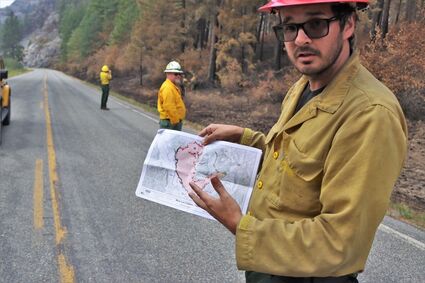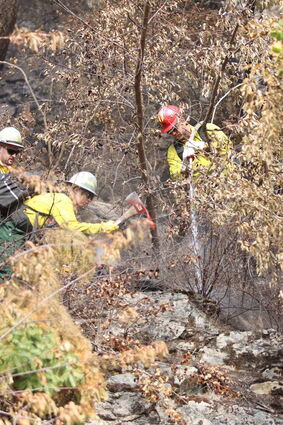Fire crew protects structures
August 26, 2021

John Dowd
FIRE CONTROL - Stephan Osmond, task force leader for the structure group working in Division November, explains the hand lines and hose lays behind him.
On August 15, the Thorne Creek fire began to quickly back down into the Thompson River canyon toward numerous homes and structures along the river. Overnight, the fire grew 6,157 acres, with the majority of that growth into the Thompson River drainage. With resources stretched thin across the west, and most of the United States at Fire Preparedness Level 5, the fire teams working structure protection had to work fast in extreme conditions.
"The rain has put the brakes on this thing [the fire] progressing. Now, we just need to get out there and seek and destroy so this thing doesn't progress," said Stephan Osmond, a Type Three engine captain out of the Bass Lake Ranger District in the Sierra National Forest in California. He is acting as task force leader for the structure group working the fire in the Thompson River area. They were the group that worked to defend the homes along Thompson River Road from the fire that Sunday night. The fire is still growing, but since last friday, the area along the river was at a low level of threat.
The night of August 1, teams employed hand lines and hose lays in conjunction with sprinkler systems in order to keep the flames from getting to houses. Hand lines are small trails or trenches dug into the earth by firefighters, to put a several foot-wide stopping line between the fire and the threatened areas. Hose lays are long hoses that run the lengths of these hand lines. The hoses have hook-up points, called gated wyes, every 100 feet with universally standardized threads. Along these points, crews can hook up sprinklers, hoses and other equipment to help fight the fires. The firefighters then tie these hand lines into other control lines, such as roads, in order to box off the fire and keep it contained. One such hand line set up on Thompson River Road that night surrounding several structures was over a quarter mile long.
These control lines act as holding points to keep the fire from spreading. The crews set up several of these to fall back on, should one have become overrun. Osmond explained that there is constant communication between the firefighters and the engine and water pump teams in order to get water to the front lines. That way, they can control the water pressure to get it up steep cliffs surrounding the structures. Osmond explained that this communication was crucial so hoses were not blown, but enough pressure could reach where it needed to go. Osmond remarked on how difficult it was to fight fire in the kind of environment found along Thompson River Road and especially getting water straight up into certain areas. Whether this communication was through the radio, hand signals or yelling, Osmond said, "We were just keeping that water moving up the hill."
According to Osmond, many people may not understand the dangerous nature involved with working a fire line, especially in steep rocky terrain like there is in Sanders County and up Thompson River Road. "It is super dangerous country to work in. I really have to look at the safety aspect of getting my guys in there," he said. "You need to take your time getting in there; make sure trees aren't going to fall down and rocks aren't going to roll down onto the guys below. It's tough on these outcroppings and this steep country."
All this work was done to protect what they called the "green island," which consisted of the several communities along the river, including the Snider and Copper King areas. The structure team received help from local volunteer firefighters, which Osmond said "were a huge help." They allowed the fire crews to "leapfrog" from area to area to keep pressure on the blaze. "You try to fortify what you have," said Osmond. "Our success on this fire has been that we haven't lost any structures."
In order to help protect the structures, days before the fire got close the firefighters went from home to home, assessing each property and how to best protect them. One thing they did was clean out all the gutters and roofs, removing leaves and pine straw needles that had collected in those places. They call these "ember traps" and they are often how a house catches fire. The teams also limbed trees to keep the fire from "laddering" or climbing low brush and hanging branches up into the canopies. Osmond explained that it is important that they build relationships with land and homeowners in order to keep them informed about how to better protect their property.
Days after the fight to protect the structures along Thompson River Road, the task force under Osmond performed mop up, where they worked to place at least 100 feet of clearance from the road and other control lines. In this tedious process, the firefighters walked up and down the lines and roads, feeling the dirt around logs, under rocks and anywhere they can to make sure the ground is cold and there are no embers left. "We're on a seek and destroy mission," Osmond explained. In Osmond's view, the firefighters' job is to keep the fire contained within its footprint. According to Osmond, were there a big blaze deep inside the fire perimeter, it would not be prudent to send crews in, because some of the fire could sneak out while crews were working inside the line, instead of using the restricted assets to protect and contain the fire line. This would also put the lives of the firefighters at unnecessary risk. "Resources are stretched thin across the west," said Osmond.
To achieve this containment, "air assets work in tandem with ground teams," said Osmond. Teams use a combination of night and day aircraft, which fly over and take both thermal readings (by plane at night) and visual inspections (with helicopters during the day). This information is relayed to crews on the ground via radio, in order to plan where the fighters need to be. The same principles are done when helicopters are used to apply water. They use two-way air-to-ground communication to coordinate where to dump water.
"It's a 360-degree fire. Most people only see the fire from their vantage point," said Osmond, explaining that the fire teams have to look at the fire from many different points of view. He mentioned the priority of protecting structures but included protecting historic and important cultural sites. They must also look at the natural impact the fire will have on the environment and fuel sources, while coordinating limited resources and personnel. Fire fighters have all these concepts flying at them all at once, as Osmond explained. According to him, it takes a lot of experience and training to achieve this balancing act.







Reader Comments(0)